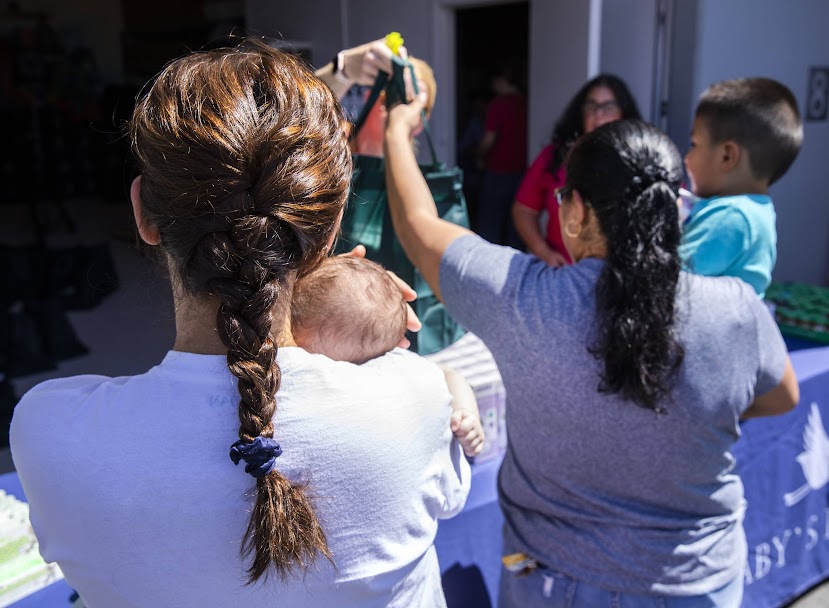Child care costs are heavy burden for Nevada families, strain child well-being

Nevada remains harnessed to near-bottom rankings for child and family well-being in comparison to other states, according to a new analysis out Wednesday, with advocates for children fearing the state’s child care gaps will come to a peak and disrupt the workforce when federal aid linked to the pandemic runs out.
According to the 2023 edition of the Annie E. Casey Foundation’s KIDS COUNT Data Book, Nevada married couples making the median income spend 15 percent of their wages on child care, the highest child care cost burden of any state in that category. Single parents in the state spend about 38 percent of their wages on child care.
The cost of services is also a hindrance for families and becomes an arm of the growing wealth gap in the state – disproportionately squandering the prosperity of single parents, women, low-income families and families of color, or reducing their chances for employment, professional development or educational opportunities.
Child care companies struggle to maintain a workforce on what one Nevada child advocate calls “woefully low” salaries amongst the economic pressures of inflation, and with strict regulations for student-teacher ratios, local providers quickly reach capacity. Many ZIP codes have up to three kids waiting for every slot available for early childhood education.
“We want Nevadans to move out of poverty and climb that economic ladder,” Tara Raines, a licensed psychologist and deputy director at Children’s Advocacy Alliance, said in an interview with The Nevada Independent this week. “Not having access to high-quality child care, where folks can trust that their kids will learn, trust that their kids will be cared for, trust that their kids will be nurtured, is really going to make it difficult for [parents] to be present at work, both physically and mentally.”
The report noted that key pandemic funding from the federal government is running out and weakening families’ ability to afford child care. Researchers said that the federal government does little to help families afford child care, only offsetting costs for about 1.3 million of the more than 12 million kids enrolled in early childhood programs across the country.
Seeking out help also becomes a barrier, as the application process can be cumbersome, and results in only about one out of six eligible children receiving support, with funding disparities hitting particularly hard in predominantly Black communities.
The Annie E. Casey Foundation recommends that federal, state and local governments invest more money in child care, and that public and private leaders work together to improve the infrastructure for home-based child care, beginning with increasing access to startup and expansion capital for new providers. The report also recommends creating plans to help young parents and expanding the federal Child Care Access Means Parents in School program, which provides child care stipends and wraparound services for students.
The report found that out of 50 states, Nevada ranked 47th for child well-being, 48th for economic well-being, 46th for education, 38th for health and 44th for nurturing families and supportive communities — not much different than the state’s scores last year. Nineteen percent, or 129,000 of Nevada’s children, are living in poverty. That’s 2 percent more than the national average, with an estimated 66 percent of 3- and 4-year-olds not in schools.
But study authors focused this year’s report on child care shortages, noting that in addition to repercussions for their parents, “young children themselves — our most precious resource, on whose future America’s economy and democracy depend — are missing out on care and early education during a period of important brain development.”
The average cost of infant child care in Nevada is between $10,362 and $13,383 a year, according to a 2022 report by Child Care Aware for America, with toddler care hovering around $9,637 to $12,028.
“We're weak on costs. We’re weak on availability. We're weak in workforce or how we pay and attract or retain the professionals who work with the kids,” Raines said of Nevada’s child care infrastructure.
Holly Welborn, executive director of Children’s Advocacy Alliance, said federal and state agencies need to help expand access, and she called for increased participation from the business community.
“We do have really high-quality child care programs in the state,” Welborn said. “It’s just a matter of [expanding] those programs.”
In 2022, former Gov. Steve Sisolak used federal stimulus money to launch a one-time $50 million investment to expand child care subsidies to families with higher incomes, and million-dollar child care hubs launched in Reno and Las Vegas to support providers and boost availability. But it’s unclear how much those initiatives moved the needle to address child care deserts, and advocates pointed to little additional action on the child care issues in the state budget or in policy bills.
Several child care-focused bills also fell short of passing in the 2023 session, including AB113, sponsored by Assemblywoman Claire Thomas (D-North Las Vegas), which would have created an Office of Early Childhood Systems within the governor’s office, and SB278, sponsored by Sen. Pat Spearman (D-North Las Vegas), which would have authorized tax credits for businesses that offer child care benefits to workers.
Raines said Nevadans need child care workers who can help identify developmental disabilities and signs of abuse so that families can get support and can respond to children’s needs.
“It's the seed to so much,” she said of child care. “We just hope that folks recognize that and really take the time to look and see how we can bolster the resources here in Nevada.”
Raines said lawmakers could help beef up child care capacity by implementing programs used in other states, such as universal prekindergarten with full-day schedules for children ages 3 and 4, increasing pathways for people to become home child care providers, treating child care work as a skilled profession and easing restrictions in homeowners associations to allow home day care services.
“I think the writing's on the wall,” she said. “We're going to have to move, and we're going to have to move quickly, to really adjust and address this problem.”
Recent child care changes
According to Annie E. Casey Foundation’s report, a third of the nation’s child care workforce dropped out two months into the pandemic, going from 1.1 million workers in February 2020 down to 677,000 that April and then recalibrating in April 2023 to 996,000 child care professionals.
The affordability has also caused parents or caregivers to miss work to care for their children in increasingly high numbers since the pandemic. Researchers said that the number had only risen as high as 60,000 prepandemic, but last October the number of parents or caregivers who said child care problems forced them to miss work in the previous week climbed to 104,000.
Some parents have dropped out of the workforce completely and in Nevada around 28,000 children live in families that faced job-related disruptions, including job loss and quitting due to child care issues in recent years. Raines said these circumstances contribute to the impoverishment of families.
“We know that if families are leaving the workforce … they're missing out on those annual cost of living raises to their base salary,” Raines said. “They're missing out on those 401K contributions … promotions, on opportunities.”
Not all bills seeking to improve the child care landscape fell by the wayside this session. A bill proposing a virtual pilot program that would support parents, caregivers and foster parents with early childhood programming such as reading, writing and science, passed and is awaiting the governor’s signature.
“We still need the workforce,” Raines said about virtual options. “I have not heard of a state that has been able to use technology to close their child care gap in a way that has been meaningful and overwhelmingly successful.”
